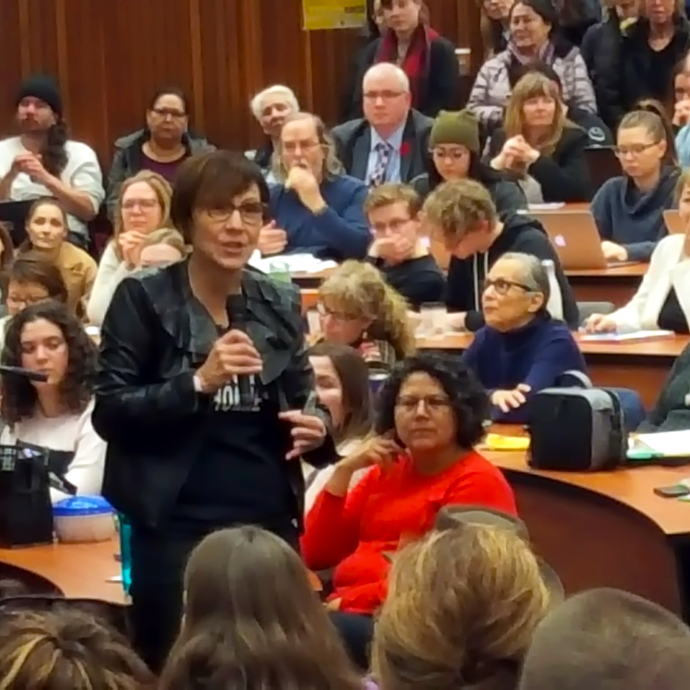
A new law that came into force on January 1 recognizes the inherent jurisdiction of Indigenous People to write and enact their own laws regarding child and family services, but it leaves them short many crucial tools, says Cindy Blackstock, a renowned scholar and activist on equality for Indigenous children in Canada.
Blackstock was a recent guest of the University of Alberta Faculty of Law for a detailed panel presentation, conducted alongside the Faculty's Assistant Professor Hadley Friedland, about An Act respecting First Nations, Inuit and Métis children, youth and families (then-Bill C-92), and its good, bad and unknown elements.
While the new law is a historically monumental piece of Canadian legislation, it was developed in less than a year, despite being the result of decades of advocacy and court cases by Indigenous People, and there are significant gaps in it, said both Blackstock and Friedland.
These include a lack of accountability mechanisms and the hazy definition of what constitutes "the best interest of a child," which creates a lot of discretion and has been problematically interpreted by non-Indigenous decision-makers, said Friedland, who testified about this issue at the House of Commons and Senate committees on Bill C-92.
Blackstock has worked on several successful human rights challenges, including a 13-year challenge that resulted in the landmark legal finding by the Canadian Human Rights Tribunal in September 2019 that stated Canada wilfully and recklessly discriminated against Indigenous children on reserve by failing to provide funding for child and family services.
This discrimination caused multi-generational suffering in ways that contributed to unnecessary removals of Indigenous children from their families and communities, the tribunal further stated. Canada is currently seeking judicial review of the compensation awards from this finding.
Lacks Funding Details
A top concern is the potentially undermining lack of detail on how First Nation groups will fund the implementation of their powers of jurisdiction, Blackstock said.
"It doesn't matter if you have your own law," she told a standing-room-only audience of UAlberta professors and students, lawyers, social workers and members of Alberta's Indigenous communities. "(With) no resources to meet your members' needs it really is a false promise."
Another problem Blackstock sees with the new Act is that it's written as a child welfare law instead of emphasizing a broader focus on family wellness, as makes more sense in in Indigenous communities and cultures. That runs contrary to what Indigenous communities' legal orders envision and imposes narrow constraints on funding, she said.
Friedland shares Blackstock's concerns but is more cautiously optimistic. She identified the creation of minimal national standards as a significant positive change in the new Act.
In the "Final Report of The Truth and Reconciliation Commission," Call to Action #4 calls for national standards for Child and Family Services delivery relating to Indigenous children and families. The Act's national standards set a 'floor,' or minimal requirements to address current inconsistencies across provinces which contribute to the gross overrepresentation of Indigenous children in care, said Friedland (50 per cent of children in foster care are Indigenous, though they make up only seven per cent of the population).
Standards & Recommendations
The national standards prioritize prevention over apprehension, set placement priorities and emphasize the importance of maintaining Indigenous children's relationships and cultural connections, she said. There are also provisions about substantive equality and a new approach to determining the best interests of Indigenous children. Friedland, whose scholarship focuses on Indigenous and Aboriginal Laws, Family Law and Child Welfare Law, is a co-lead of the Wahkohtowin Law and Governance Lodge.
Blackstock and Friedland made several recommendations to Indigenous communities who decide to exercise their jurisdiction to write and legislate their own laws, which will have the force of federal law under the new Act in one year if the Indigenous governing body gives notice and negotiates (or makes reasonable efforts to negotiate) a co-ordination agreement with provincial and federal governments.
Blackstock strongly suggested that Indigenous groups negotiate a funding agreement first. Do not assume that any money currently available to First Nations agencies under existing programs will transfer over to be used for implementing this new jurisdiction, she said.
"That's a false assumption," she said. "Canada has something called Terms and Conditions and it has restricted the monies payable to agencies to only those operating under provincial and territory law."
Friedland suggested taking an incremental approach rather than assuming law-making is all or nothing. She further suggested that Indigenous groups educate themselves about the legislation, advocate to make sure it's interpreted in a way that makes sense for them, develop their own definitions of "best interest of a child," and work with other Indigenous groups and nations to share strategic approaches and resources.